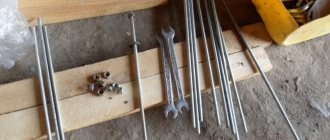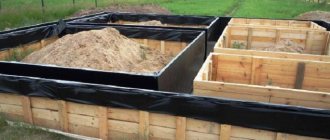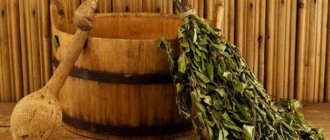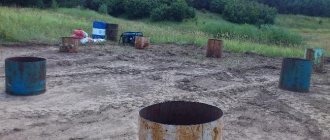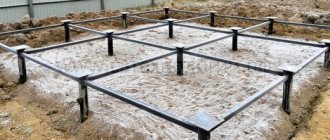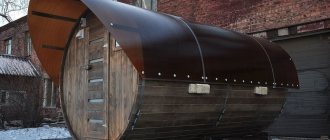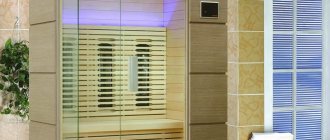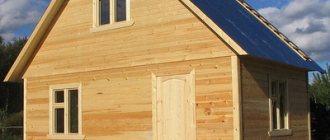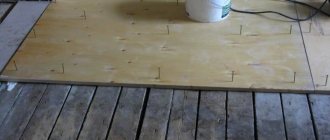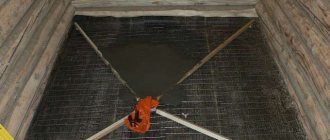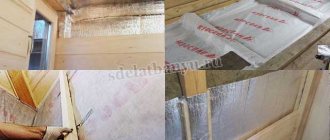19.07.2016
Any construction begins with a foundation. What is it for? The task of this structure is to bear the weight of the entire structure and take the entire load and distribute it evenly over the entire area. How reliable the foundation is will determine how long your building will last and how long the foundation will last without repair. One of the most negative influences on the foundation is water. Therefore, it is important to ensure that the foundation waterproofing is done correctly. In the article you can read about what waterproofing is, what it is like and what it is.
Newly built foundation for a bathhouse
Vertical waterproofing
This type of protection is applied to the entire height of the foundation, starting from the sole. Its upper limit is determined by the level of splashing when precipitation hits the walls. Select the type of application depending on the amount of moisture in the soil. Before applying any type of waterproofing, it is necessary to carefully repair all defects: potholes, chips and sinkholes. If the foundation is block, the joints must be sealed with special moisture-resistant plaster. Waterproofing materials are laid on the outside of the building, providing protection against water penetration into the building.
Vertical waterproofing of bathhouse foundation
The most economical option for vertical waterproofing is mastic coating. It protects well from moisture penetration into the structure, but is easily damaged already at the stage of backfilling the foundation: the soil contains stones, fragments of broken brick or other building materials that can damage the protective layer. The protective bitumen film is also damaged when the soil shifts during operation. To avoid any damage, a layer of insulation or geotextile is placed on top of the mastic, and sometimes a pressure wall is built from brick (a rather expensive option). Instead of bitumen, you can use various penetrating water-repellent solutions and mastics. They provide a high degree of protection, but are more expensive.
Vertical waterproofing using roll materials
The next most expensive option is adhesive waterproofing using rolled materials: roofing felt, technoelast or isoelast.
There is also plaster waterproofing, in this case, a mineral-cement mortar with special additives is applied to the walls in several layers (total thickness up to 22 mm). Plaster insulation is applied hot - this helps to avoid cracks.
Using water-repellent impregnation: effective, but expensive
What materials are best to use
When building a bathhouse, many cannot decide how best to treat the foundation from moisture. Today, waterproofing additives, rolled materials and coating mixtures are very popular.
- Roll materials. They are presented in a wide range: roofing felt, ecofleck, isoelast, antechamber, krembit, etc. They have different components and differ in manufacturing technology. They attract with an affordable price and high levels of strength, ductility, elasticity and tear resistance.
- Coating mixtures. They are made on a bitumen basis. Reliably bonded to surfaces due to excellent adhesive properties. They also suppress vibrations of the building foundation, since the structure of the mixture is quite elastic.
- Waterproofing additives. They are divided into different types:
- Liquid – reduce the degree of porosity of the foundation;
- Elastic additives – increase the viscosity of the solution and improve water resistance;
- Dry - penetrate into the deep cracks of the foundation, ensuring its safety.
All of the listed materials are complete components for waterproofing. To ensure the most effective protection of the bathhouse foundation, it is better to combine several waterproofing materials.
Horizontal waterproofing
Horizontal waterproofing protects the structure from capillary penetration of moisture. If you are building a bathhouse with a basement, then the first level is under the ceiling of the basement. The second level of horizontal waterproofing is at the level of the junction of the walls and the foundation. Particular attention should be paid to sealing the connection between horizontal and vertical insulation. All joints must be carefully coated and glued.
Horizontal waterproofing of the foundation
The simplest and most popular method is roofing felt laid in several layers. Next in popularity is impregnation with bitumen mastic or other water-repellent compounds. Also popular are the latest generation membranes, which provide reliable insulation. To install, just heat them on the burner, press them tightly to the surface and carefully level them with a roller. Membranes provide a good degree of protection, but small cracks and pores still remain, making these materials less effective than bitumen. The greatest efficiency can be achieved by combining materials: coating and film.
What destroys the lower crowns of log houses
Modern technology for building wooden houses involves installing a log house on a stone foundation.
In this case, the foundation of the house is exposed to several dangerous factors:
- capillary moisture coming from the foundation;
- humid atmosphere from the basement;
- lack of sunlight, since the lower part of the wall is often in the shadow area;
- drip moisture and temperature changes from the outside of the walls.
Damaged logs
In the latter case, the situation is aggravated by the fact that if the base configuration is incorrect, moisture flowing from the walls during rain accumulates in the lower logs and in the inter-crown seals.
A direct consequence of the factors listed above is the development of microbiological formations in the wood, affecting its structure and ultimately leading to a complete loss of strength in the lower crowns of the frame.
The greatest biological danger to logs is represented by fungal structures, the first signs of which are the so-called blue discoloration, sometimes penetrating into the very core of the log.
The nutrient medium for such fungi is lignin, cellulose and oxygen. But the main catalyst for their development is always high humidity.
The second factor in the biological damage to wood is wood-boring beetles, the appearance of which is almost always associated with fungal infection of wood.
Taking into account the above, the main methods for solving the problem of lower crowns are:
- saturation of wood with antiseptic compounds that impede the development of microbiological formations;
- reduction in the capacity of the external capillaries of the logs, necessary to stabilize the internal moisture content of the wood at an acceptable level.
As mentioned earlier, the solution to the listed problems is carried out not only through additional processing of wood, but also through the use of special design solutions, the most significant of which will be discussed below.
Waterproofing between foundation and masonry
Any concrete, even with excellent water-repellent properties, contains some amount of water. Moreover, he also absorbs it. Inside, it spreads both vertically and horizontally through tiny pores that penetrate the concrete stone. If the walls are made of hygroscopic material - and this includes brick, wood, and almost all building blocks, then in the absence of waterproofing, moisture will be absorbed by them. The walls will be constantly wet, the development of mold and fungi will begin, and the destruction of materials will begin.
The result of poorly done foundation waterproofing
To avoid such a development of events, waterproofing between the foundation and the wall is mandatory. This is the option when it is better to play it safe, since correcting something poorly done is very difficult and expensive.
What materials to use
Traditionally, in bathhouses and houses, roofing material is laid in two layers on a strip foundation. It is cut into a strip twice the width of the tape, folded in half lengthwise and glued to the mastic. Before laying, you need to remove all debris and foreign small objects from the surface: if you get a pebble, it will sooner or later break through the waterproofing. And this will lead to “suction” of moisture into the wall. Therefore, if the surface of the tape is very uneven, it is better to level it by pouring a thin screed, and it is better to take care of this at the stage of pouring the foundation. In order not to level the surface manually, but at the same time improve the characteristics of the solution, use a concrete vibrator. As a result, the surface will be smooth and the concrete will have improved frost resistance.
For horizontal waterproofing between the foundation and the masonry or the first crown, you can use modern materials:
- Hydrobelt is a dense, durable film made of polyvinyl chloride (PVC). Operating temperature range from -40°C to +80°C.
- Ruberit is a modern bitumen-polymer roll material, with a use temperature from -35°C to +90°C.
- Aquaizol is made from fiberglass or polyester. The scope of use is similar.
These are the most popular, but in general, the list goes on. In principle, any of the modern rolled euroroofing felts can be laid between the foundation and the wall, only without backfill, but underlays, which are used for waterproofing roofs.
For lovers of ancient recipes, there is also one method that was used in the northern regions of the country. When building a log house, soak the board twice with hot salt-bitumen solution on both sides. And in this form, place it under the lower crown. In addition to waterproofing, such impregnation also provides antifungal protection.
Optimal choice of foundation for a log house: price vs quality
When choosing a foundation, it is fundamentally important to pay attention to the following parameters: soil composition, load and area of the structure, terrain of the site. Don't forget about the price-quality ratio. A profitable solution when building a small house or cottage would be a columnar foundation. A more solid structure with a long-term future would be better placed on a strip foundation. The amount of costs will be ¼ of all costs. You will be pleased with the quality and reliability, as well as the good possibility of constructing a basement or garage or basement. Labor-intensive, requiring considerable costs - a pile foundation. The price is justified only in the presence of unreliable soil, where another option cannot be secured. A screw foundation is economically beneficial: at minimal cost you get a reliable, earthquake-resistant, quickly erected frame for a house. Its cost is half lower compared to other types of foundation. Regardless of the type of foundation chosen, a quarter of the cost will be spent on installation. A reasonable approach and correct calculations will reduce costs without sacrificing quality. The price is influenced by: the material used; type and size of the building being built; foundation width; installation method. An important point when carrying out work is waterproofing.
Waterproofing a brick foundation
Waterproofing of a brick foundation must be carried out in full and very carefully: the brick, in the presence of moisture, quickly collapses, and it is even worse affected by freeze/thaw cycles. Therefore, it is necessary to carefully limit the flow of water.
They start with waterproofing the cushion, which is made under the base of the foundation. Roofing material is laid on compacted and leveled soil. Can be done in two layers. A leveling cushion of crushed stone and sand is poured on top. Then the concrete base strip is poured. After it is ready, roofing material is also rolled out onto the base or the surface is coated with bitumen-polymer mastic. Then they begin laying the brick foundation.
Under a brick foundation, the first layer of waterproofing is laid on the ground, the second - under the brickwork
After the walls are erected, external waterproofing work must be carried out. Two layers are used - one of bitumen-polymer mastic, GIDROPLAST or other similar material, the second - rolled material (eurorubberoid or polymer spike-shaped membranes) is glued onto it.
Since the mastic must be applied to a relatively flat wall, sometimes it needs to be leveled. This significantly increases the cost of construction and takes a lot of time, since a dry base is required (the humidity of the wall on which waterproofing is applied should often not exceed 5%). You can find cement-based compositions that will simultaneously level the foundation wall and serve as waterproofing.
Protective ebb
In some cases, it makes sense to mount additional flashings above the lower crown, minimizing the flow of moisture into the first inter-crown seams.
On the front facades of houses, such a solution is not always acceptable for aesthetic reasons, but on the rear walls, which are often shaded or stand adjacent to outbuildings, such protection will not be superfluous.
Please note that it is advisable to make such ebbs from the most protected material, since it will have to work in conditions of constant humidity.
Waterproofing the foundation slab
Slab foundations for bathhouses are not often installed, but sometimes - on unstable and heavily heaving soils - this is one of the best solutions. In addition to the labor-intensive work of preparing the pit and then tying the reinforcement, it is also necessary to carry out thorough waterproofing work. Moreover, they consist of several layers.
The first stage is laying waterproofing under the slab - on the bedding. Previously, roofing felt was used for this. But it is made on the basis of cardboard; the bitumen used has low elasticity. But there was no alternative; we worked with what we had. Today there is a wide selection of roll waterproofing. Outwardly, it is very similar to roofing felt (Stekloizol, Rubemast and the like). Their difference is that they are made on the basis of fiberglass (more durable) and fiberglass. They are impregnated with modified bitumen, which does not lose its plasticity at sub-zero temperatures. This material has better characteristics and a longer service life. It is advisable to use these materials for waterproofing slab foundations.
The entire slab foundation is covered with waterproofing
They are laid directly on top of the bedding (a rough screed was made under the roofing felt). The strips overlap each other by 10 cm, the joints are glued with mastic and pressed to ensure tightness. Along the perimeter, the waterproofing should be 20-25 cm larger, it is then placed on the slab.
After installing the reinforcing belt, pouring and curing the concrete, proceed to the second stage of laying the waterproofing of the slab foundation. Now we need to isolate the monolith itself. This can be done using the same roll materials. Only this time they are fused using a torch using standard roll roofing technology. This option is not the only one, there are others:
- Coating waterproofing - bitumen and bitumen-polymer mastics. Apply to a dry, even base using a brush or spatula. Creates a waterproof film on the surface. Therefore, it is advisable to apply it in two layers, and in different directions, so that the coating is continuous.
Penetrating impregnation. Here the mechanism of action is different. Chemically active components clog the pores that exist in concrete. This significantly reduces the water permeability of the base slab. Impregnation is applied with a brush, the number of treatments is also double. But be sure to read the instructions: some compounds need to be applied to a dry base, some to a wet base, and a certain amount of time must be maintained between applying layers. An example of such material is “Penetron”. It can be used to reduce the hygroscopicity of any concrete, brick and foam concrete surfaces.
The first waterproofing layer is laid on top of the concrete preparation layer
Which way is better? Probably coating and roll waterproofing. Why? They are also a vapor barrier at the same time. After all, water in the soil is present not only in liquid form, but also in the form of vapor. And impregnations make concrete impermeable to water, not to steam. To protect against it, another layer is required. At the same time, both mastics and Euro-roofing felts do not allow water to pass through in the gaseous state. So these materials are better in this case.
Please note that the side surface of the slab foundation is also coated with liquid waterproofing, and then the remaining edge of the rolled material (the one that lies on the bedding) is wrapped and glued to the mastic. When laying two layers of rolled material, roofing material, which goes from below, is first glued to the sides of the slab. Then the one laid on top is bent and also “sits” on the mastic.
Types of waterproofing according to application method
For a bathhouse, you can use all manufactured types of waterproofing materials, but each choice must take into account the operating conditions of building materials and structures and the technical characteristics of insulation. What kind of waterproofing is there?
Coating
Coating waterproofing
It can be one-component or two-component, produced in the form of mastics of various chemical compositions, most often based on modified bitumen or polymers. The thickness of the applied layer is 2÷4 mm; for some objects operating in particularly difficult conditions, the thickness of the waterproofing layer can increase to several centimeters.
Bitumen mastic
It is used to protect foundations from capillary moisture, rain and groundwater, in most cases it is used for treating concrete structures. Can be the main covering material for flat roofs.
Bitumen mastic - use on the roof
Brands and characteristics of coating waterproofing
| Name | Short description | Place and method of use | Price |
AquaMast | Made on a water basis, waterproofing material – bitumen mastic | Can be used at temperatures from -5°C to +40°C. Apply to brick, concrete and wood substrates, for outdoor use | 221 rub. per package 3 kg |
Grida MGH-T | Cold mastic, does not require heating. Has excellent adhesion to most building materials. | Apply manually with a brush or air spray. Consumption rate – no more than 1 kg/m2 of surface with a layer thickness of 1 mm. For external work, can be operated at temperatures -40°C+80°C. | 937 rub. per package 18 kg |
TechnoNIKOL No. 01 | In terms of water resistance, it belongs to category W0, on a bitumen basis. | The concentrate should be diluted with plain water before use. Can be applied with a roller, brush or spray. Consumption rate per square meter of surface is 0.35 kg. | 1800 rub. Per package 18 kg |
| DOCKER | The manufacturing material is modified bitumen, has increased physical strength, and is elastic. | Apply with a roller or brush on clean and smooth surfaces. Work is allowed only in dry weather at positive temperatures. | 1256 rub. per package 10 kg |
Such mastics can be used to waterproof bathhouse floors built on a concrete base; it is also possible to coat walls made of foam concrete or brick.
Coating waterproofing of the floor
Waterproofing walls - photo
- Advantages. In terms of cost, they are one of the cheapest types of materials. Universal in use, increase productivity. Modern mastics do not require heating before application.
- Flaws. They require careful preparation of surfaces; at low temperatures they can significantly reduce elasticity.
Professional builders recommend using coating waterproofing in combination with other materials.
Insulating structures can only be done in dry weather; the surfaces should not have significant damage.
Prices for coating waterproofing
coating waterproofing
Pasting
Waterproofing pasted outside the house
Sold in rolls, various materials are glued to the base. It is used only for external insulation of concrete structures; among the most well-known are glassine, roofing felt, roofing felt and modern materials based on fiberglass. The external insulating coating can be made of ordinary or modified bitumen. They are distinguished by improved characteristics and durability, and are priced in the low-cost category.
Pasted waterproofing of surfaces
Brands and characteristics of adhesive waterproofing
| Name | Brief description of characteristics | Place and method of use | Price |
Bipole EPP-3.0 | Both the front and back sides are coated with a protective composition; it can be used at temperatures of -70°C+150°C. | It is used during the installation of roofing coverings with soft tiles. Apply to dry surfaces at positive temperatures | RUB 1,655/roll |
Ruberoid RPP 300 | The most well-known coating and insulating material is modified bitumen. The base is durable cardboard. Water resistance W0. | For waterproofing foundations and roofs, does not require preheating, has high adhesion to all types of building materials. Heat resistance +80°C. | RUR 343/roll |
Technoelast EKP slate gray | The base is non-woven artificial fiber, characterized by improved physical strength characteristics. | It is used during installation of soft roofing coverings and can withstand significant mechanical forces. | RUR 1,955/roll |
| TechnoNIKOL Technoelast EPP | Modified bitumen is applied to reinforced cardboard and has a number of special additives to improve performance characteristics. | To protect various structures, universal use, does not require preliminary preparation. Apply with a roller or brush. Waterproof W0, thickness 4 mm, roll width 1 m. | RUR 1,734/50 kg |
The disadvantages include the following features:
- surfaces must be smooth and dry, it is advisable to carry out work at positive temperatures. Manufacturers of innovative components using thermoplastic and elastomeric materials allow waterproofing work to be carried out even at sub-zero temperatures, but builders with extensive practical experience do not advise listening to their recommendations;
- the difficulty of waterproofing architectural structures with complex geometric shapes.
Prices for adhesive waterproofing
waterproofing
Painting room
Painting waterproofing - photo and definition
Various types of paints and varnishes made using innovative polymers and silicone resins. They can be used both indoors and outdoors and have good qualities. They are simple to use, and in terms of price they fall into the category of cheap waterproofing materials. The service life, depending on the brand, ranges from 5 to 8 years.
Brands and characteristics of paint waterproofing
| Name | Brief description of characteristics | Place and method of use | Price |
| Polyacrylic Kobus | Made on the basis of polyacrylic resins, aqueous dispersion, environmentally friendly. | For interior work, coating can be done with a roller or brush on prepared surfaces. Consumption per square meter up to 120 g. | RUR 784/5 kg |
Polyurethane Hyperdesmo | The innovative components have a high degree of adhesion to all building materials and do not require prior preparation before use. | Universal use, can be used to coat external and internal surfaces. Apply by hand or spray onto clean, dry surfaces. | 606 rub./1 kg |
Rubber-rubber KBS KN3 Universal | The most modern material with improved performance characteristics. | For waterproofing concrete and brick walls, it can be used on concrete flooring. Apply by hand with a roller or brush. Consumption per square meter 0.5÷1.0 kg. | RUR 1,176/22 kg |
Painting waterproofing
Sprayable
Recently it has been widely used; it can be two- or one-component. Available in water-based or special solvents. Sometimes called liquid rubber, its performance characteristics fully meet the requirements of developers. Universal use, quite expensive in price. It is afraid of mechanical influences; it can only work in windless, dry weather at positive temperatures. Careful preparation of surfaces is required. It is impossible to apply such waterproofing yourself; special expensive equipment is required. Recommended for use on external surfaces only.
Liquid rubber – sprayed waterproofing
Brands and characteristics of sprayed waterproofing
| Name | Brief description of characteristics | Place and method of use | Price |
| Polyurethane foam | Universal, dual-use, simultaneously insulates and insulates surfaces, applied only by qualified specialists. Physical strength indicators are low. | Internal and external surfaces of walls and foundations are applied using special equipment. | 12000 rub./m3 |
Liquid rubber | Bitumen-polymer material has high plasticity characteristics and completely isolates surfaces from moisture penetration. | Apply only by specialized companies to previously prepared dry surfaces. | 240 rub/kg |
Sprayed waterproofing - photo
Polyurethane foam waterproofing has a special place. It not only protects surfaces from moisture, but also serves as an insulating material. In terms of performance, it satisfies builders and can be applied to surfaces of any shape and configuration. The disadvantage is the high price and complexity of application. Work can only be carried out by specialized companies.
Video - Waterproofing with polyurethane foam
Penetrating
Penetrating waterproofing is the best protection for your home
Operating principle of penetrating waterproofing
Penetrating waterproofing - the result
Special mixtures based on Portland cement with the addition of various ingredients have high levels of physical strength and are used only on concrete or brick surfaces. Both internal and external surfaces can be waterproofed. Work is carried out only at positive temperatures, it is repairable. Before starting work, surfaces must be thoroughly cleaned.
Brands and characteristics of penetrating waterproofing
| Name | Brief description of characteristics | Place and method of use | Price |
| Penetron | Made from polymers, it can withstand high water pressure. | To seal cracks, it can serve as additional waterproofing for particularly dangerous units. Application requires special equipment. Consumption per square meter of area 1 kg. | 360 rub./kg |
Premkhor | The composition contains innovative polymers and requires preliminary preparation. | It is used during major or emergency repair work, for special purposes. Fast-setting, hardening speed does not exceed 8 minutes. For waterproofing seams and cracks in concrete structures. | 300 rub./kg |
PROQUICK | One-component waterproofing material based on innovative polymers. | For emergency repair of foundation cracks, water consumption 1 l/1.6 kg. Does not shrink, sets quickly. | 340 rub./kg |
Penetrating waterproofing - application
For wooden materials, special impregnations are used to prevent the formation of mold and increase protection from open flames. But these staves are not considered waterproofing, nor do they limit the penetration of moisture, but only minimize the negative consequences of its presence.
Prices for penetrating waterproofing
penetrating waterproofing
Injection
Injection waterproofing
Performing injection waterproofing
It can be considered a repair, it is never applied to the entire surface, but is injected only into problem areas. Most often used during major or current repairs of buildings, it can be used on concrete or brick foundations. Contains special polymer compositions and can withstand significant groundwater pressure.
Brands and characteristics of injection waterproofing
| Name | Brief description of characteristics | Place and method of use | Price |
| Gecko IPE | The material of manufacture is polyurethane, it sets quickly. | For injection of cracks of various sizes, can be used for repairing concrete and brick surfaces. For sealing the junctions of individual concrete elements. | 3000 rub./m. P. |
Gecko IP1 | Based on polyurethane modified resins. | For the production of injections into technological or emergency voids. | 4500 rub./m. P. |
To operate, it requires special equipment capable of creating high pressures. It is applied both into existing cracks and into existing technological holes.
Membrane
Waterproofing membrane
It is very widely used during the construction of various buildings and structures, has many types, and is characterized by high reliability indicators. It is made on the basis of non-woven materials and, simultaneously with waterproofing, can allow moisture to pass through in a vapor state - a unique quality of superdiffusion membranes. The disadvantages include the rather high cost. In addition, these materials require unconditional implementation of the recommended waterproofing technologies; improper performance of the work can dramatically reduce efficiency.
Brands and characteristics of membrane waterproofing
| Name | Brief description of characteristics | Place and method of use | Price |
| Ecoplast V-RP | During production, PVC is used on a non-woven synthetic fabric, withstands stress ≤ 19 MPa, and has excellent resistance to punching forces. A polymer mesh is used for reinforcement. | For waterproofing roof coverings made of various materials. Membrane thickness 1.2 mm. | RUR 302/roll Width 2.05 m, length 25 m. |
Logicroof T-SL | Used during waterproofing of underground surfaces. The top layer of the membrane (signal) is yellow, the maximum elongation before ruptures appears is at least 200%. | For reliable insulation of concrete and brick surfaces, fixed by welding (hot air). | RUR 390/roll. Width 2.1 m, length 20 m. |
Monarplan D | Polymer membrane for universal use, the latest development using modified plastics (plasticized PVC). | For reliable waterproofing of internal and external surfaces, it is laid on flat, dry surfaces. Fixed mechanically and welded at the seams with hot air | RUR 738/roll. Width 1.5 m, length 20 m. |
| Carlisle PVC Sure Flex | Thickness 1.27 mm, reinforced with durable polymer mesh. | It has high levels of physical strength and can withstand long-term static loads. Excellent resistance to punctures, used for reliable waterproofing of various surfaces of buildings and structures. | 426 RUR/roll. Width 2.06 m, length 30.48 m. |
Membrane fixation
MONARPLAN FM/D. MEMBRANE FOR WATERPROOFING. File for download
MONARPLAN FM/D
LOGICROOF® T-SL. Polymer PVC membrane for waterproofing. File for download
LOGICROOF® T-SL
GOST 30547-97. ROLL ROOFING AND WATERPROOFING MATERIALS. File for download
GOST 30547-97
Membrane waterproofing on the roof
We are confident that the knowledge gained will allow you to correctly select not only the types of waterproofing, but also the methods of its application. Let's consider the features of waterproofing all bath structures.
For baths, ordinary polyethylene film or aluminum foil can be used as waterproofing. Film is a cheap, completely reliable material. Aluminum foil is the only waterproofing that can one hundred percent guarantee the protection of surfaces from moisture penetration. But on one condition: all manufacturers’ recommendations are taken into account. The disadvantages of foil are rather low physical strength and high price.
Foil fabric
Waterproofing with foil
Video - Waterproofing with foil
Waterproofing strip foundation
The use of modern technologies in construction leads to the fact that vertical waterproofing of strip foundations is not always necessary. Horizontal is absolutely necessary (between the foundation and the wall).
Two layers of rolled waterproofing are laid on the strip foundation under the first row of masonry (can be coated twice with bitumen mastic)
When not to do it
If there is no basement in the bathhouse or house, in most cases additional measures to protect against water are not needed. If concrete grade B15 or higher was used when pouring, then its frost resistance and water-repellent properties are sufficient to resist the harmful effects of water for decades. For such staves, the number of defrosting/freezing cycles that they can withstand is 300.
The construction of a blind area around the house and thermal insulation of the foundation also add vitality to the foundation. The presence of these components cuts off most of the water. And the concrete will handle the rest itself. After all, for normal well-being, cement needs water, only then does it “live” for a long time.
When to do it is necessary
If the house has a residential basement, regardless of the brand and properties of concrete, a full range of waterproofing and vapor barrier work is required. The main task then is to make a “trough” from insulating materials through which neither water nor water vapor will penetrate inside.
You can use any material that provides hydro- and vapor insulation. Then it all starts with waterproofing, which is laid on the bedding. It is better to use materials such as Stekloizol, Aquastop, Rubemast, etc. Next, after casting and ripening of the base, a layer of protection against water penetration is placed on the mastic. Next, the reinforcement frame is knitted, the formwork is installed and everything is filled with concrete. After setting, begin vertical waterproofing. In this case, a combination will work best: a layer of mastic or impregnation, and on top - a fused roll of waterproofing or a sticker of a spike-shaped polymer membrane.
If the basement is planned to be heated, the foundation must be insulated. The best material for this is slab polystyrene foam. It has excellent heat-protective characteristics, does not rot, and is not damaged by insects and rodents. Plus, it has waterproofing properties. And only on top of the thermal insulation layer is a waterproofing layer applied. Although, with proper installation of polystyrene foam (in two layers, the seams are staggered and taped), there is no longer a need for it. But you can play it safe. Only rolled materials will have to be glued onto mastic again: fusing onto polystyrene foam will not work.
Expanded polystyrene boards provide both insulation and waterproofing
In any case (with or without insulation) on soils prone to heaving, it is better to use membranes. Due to the large number of rounded spikes, they still partially compensate for the forces of heaving. On the other hand, the presence of air between the membrane and the foundation wall serves as an additional heat-insulating layer. So polymer membranes solve the problem of protecting the foundation in a complex (water + steam + heaving + thermal insulation).
During further work it will be necessary to waterproof the floor in the basement. Moreover, it must be done in such a way that it and the waterproofing of the foundation form a single whole and the possibility of leakage at the joints is excluded.
If you have a residential basement, you need to properly waterproof it
Upon completion of the foundation work, it is advisable to make an insulated blind area around the bathhouse or house. Firstly, it will divert water from the walls to a safe distance, and secondly, it will protect the foundation from freezing.
Vents in the foundation
Most often on construction forums you can come across the question “Why is the lower crown wet if its waterproofing is carried out according to all the rules?”
The answer, as a rule, lies in insufficient vents in the foundation, which causes humid air from the subfloor to saturate the lower logs with moisture.
Note that proper ventilation of the subfloor or basement is a higher priority than treating logs with moisture-proofing agents.
Vertical (lateral) coating, welded, glued, plaster waterproofing of strip foundations and anti-corrosion coating of screw piles is a separate topic. No less important is a barrier to prevent the effects of moisture from the foundation, dew and rainwater (accumulating on its horizontal surface), on half-logs and the lower crowns of a house or bathhouse. It is not easy to replace them when they rot (in advanced cases up to the window sills). Floor joists are usually cut into the lower crowns. If they deteriorate + complete overhaul of the entire floor with insulation. Therefore, they are ventilated with vents in reinforced tape. And on top of it they make a horizontal cut-off moisture barrier for the log house from the foundation.
For these purposes, roll waterproofing is laid on the base of the foundation (above-ground part) - Ruberoid (RP...) or modern Stekloizol (...PP). The latter is preferable. The fiberglass in its composition is superior in water-repellent properties to fragile cardboard sprinkled with asbestos and impregnated with bitumen in the composition of Roofing Material. There is no specific smell. To horizontally waterproof the bottom of the frame from artificial foundation materials foreign to wood, the rolled material is laid on at least 2 layers. Under the weight of solid wood, it fills uneven areas on the surface of the foundation. To prevent the formation of dew at the junction of different materials, an additional board is placed between the log house and the moisture insulation.
The backing board serves to redistribute the load from the log house to the foundation. And most importantly, it works as part of a complex waterproofing system.
Strip foundations are usually wider than logs. Melt and rainwater accumulate on the foundation ledge insulated with Stekloizol. The dew falls. The moisture remains until it dries. There is an opinion: the lower crowns of a larch frame do not need a backing board. Not true. Any log house needs shut-off moisture insulation. Until the backing board rots, the mortgage crown will not begin to deteriorate. A wide backing board made of larch is a reliable, reasonable solution. Pine/spruce won't last long. Because a wide board is usually cut from the middle of a tree, the core part is durable only in larch.
There is no need to insulate the board between the log house and the foundation. But it will be necessary to caulk this place in a year.
It is advisable to make the foundation base higher. Rain splashes ricochet from the ground into the frame. Reduces the ricochet of splashes by tilting the foundation blind area outward. It is preferable/cheaper to make a brick base. Made of sand-lime brick. Red ceramic is prettier, but tolerates moisture less well. Capillary suction of moisture from the soil foundation is regular. It is also necessary to waterproof the brick from the concrete. There are now enough materials for waterproofing. Not like in the old days: melted pine resin + birch bark as a “roll” waterproofing.
If, during the construction of a residential building, the waterproofing of the foundation was carried out in violation of technology, without taking into account the groundwater level or the amount of precipitation in the construction region, then over time the basement will turn into a swimming pool, a breeding ground for fungi and mold. To correct the situation, you will need to waterproof the foundation on the inside of the house. For this, different technologies and materials can be used. The choice of waterproofing method should be made depending on the degree of destructive effects of moisture on the floor and walls of the basement or cellar. Even if the house is built from a log frame or profiled timber, its foundation needs high-quality waterproofing.
Features of waterproofing a pile or columnar foundation
It is very difficult to protect piles and pillars from moisture penetration. To increase waterproofing properties, concrete piles are made with special water-repellent additives. If wooden piles are used to construct the foundation, it is necessary to treat them with protective compounds.
Waterproofing of pile foundation
The actual layer of waterproofing materials in these cases is laid along the grillage (part of the foundation that combines piles/pillars into a single structure). When insulating a columnar or pile foundation, roofing felt is usually used, which is laid in several layers.
If you take into account all these features and nuances, you can make high-quality waterproofing of the bathhouse foundation with your own hands. If you know how and what to do, it won’t be difficult.
